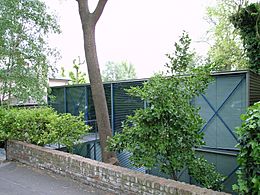Patty Hopkins facts for kids
Quick facts for kids
Patty Hopkins
|
|
|---|---|
| Born |
Patricia Ann Wainwright
1942 (age 82–83) Stoke on Trent, Staffordshire, England
|
| Alma mater | Architectural Association |
| Occupation | Architect |
| Spouse(s) | Sir Michael Hopkins |
| Awards | Royal Gold Medal for Architecture |
| Practice | Hopkins Architects |
Patricia Ann Hopkins, also known as Lady Hopkins, is a famous English architect. She won the Royal Gold Medal for Architecture in 1994 with her husband, Sir Michael Hopkins. This award is one of the highest honors in architecture. She was also appointed an Officer of the Order of the British Empire (OBE) in 2024 for her great work in architecture.
Contents
Early Life and Education
Patty Hopkins was born in 1942 in Stoke on Trent, England. Her parents were doctors. Her grandfather was also an architect, which might have inspired her.
She went to a boarding school called Wycombe Abbey. At first, she thought about studying science. But then, she decided to become an architect. In 1959, she joined the Architectural Association in London. She was one of only five women in a class of 60 students. When she was 20, she married her fellow student, Michael Hopkins.
Building a Career
After finishing her studies, Patty Hopkins started her own architecture business. In 1976, she and her husband, Michael, created their own company called Hopkins Architects.
Their Unique Home
One of their most famous early projects was their own home in Hampstead, London. They built it themselves in 1976. This house was special because it had clear glass walls and a visible steel frame. It also had very few inside walls. They designed it to be a flexible space. It was their home, but also their office for eight years.
Innovative Designs
Patty and Michael Hopkins were known for using new and interesting materials in their buildings. For example, they used lightweight fabric for the Mound Stand at Lord's Cricket Ground in 1987. They always tried to find new ways to build and design.
Awards and Recognition
In 1994, Patty and Michael Hopkins received the Royal Gold Medal for Architecture together. This is a very important award from the Royal Institute of British Architects (RIBA). The award praised their work, saying it appealed to both everyday people and other architects. In the same year, Patty Hopkins played a big part in designing the new Glyndebourne Opera House.
She also became an Honorary Fellow of the Royal Institute of Architects in Scotland (RIAS) in 1996. Then, in 1997, she became an Honorary Fellow of the American Institute of Architects (AIA). These honors show how much her work is respected around the world.
In 2011, Patty Hopkins shared her thoughts on being a woman architect. She said that when she was younger, some older men were a bit bossy. She also mentioned that some clients might still feel uncomfortable with women architects. But she said it didn't bother her. She sees herself simply as an architect focused on her work.
Important Discussions
In 2014, there was a discussion about a BBC TV series called The Brits Who Built the Modern World. The show focused on five male architects, including Patty's husband, Michael. Some people noticed that Patty Hopkins was not clearly shown in a photo used for the series, even though she was a full partner in her husband's firm. This led to talks about how women architects are recognized. The BBC said they had discussed her involvement with Patty Hopkins. All six architects were part of a related exhibition by RIBA.
See also
 In Spanish: Patricia Ann Wainwright para niños
In Spanish: Patricia Ann Wainwright para niños


